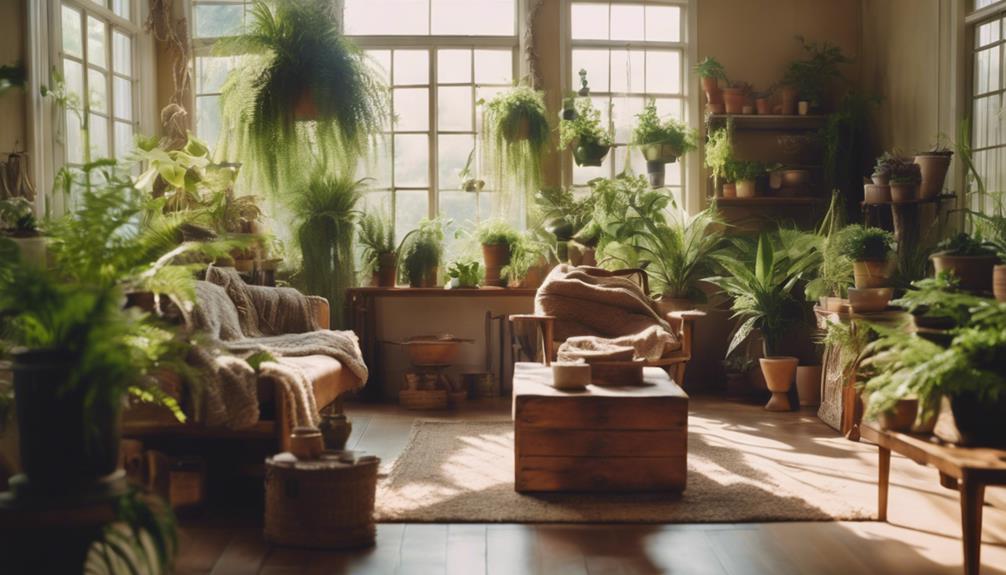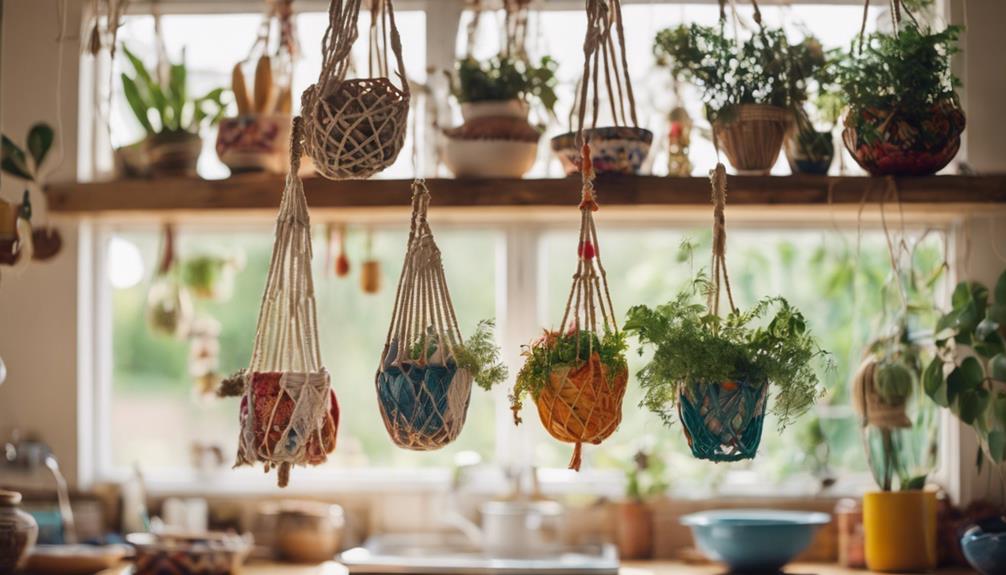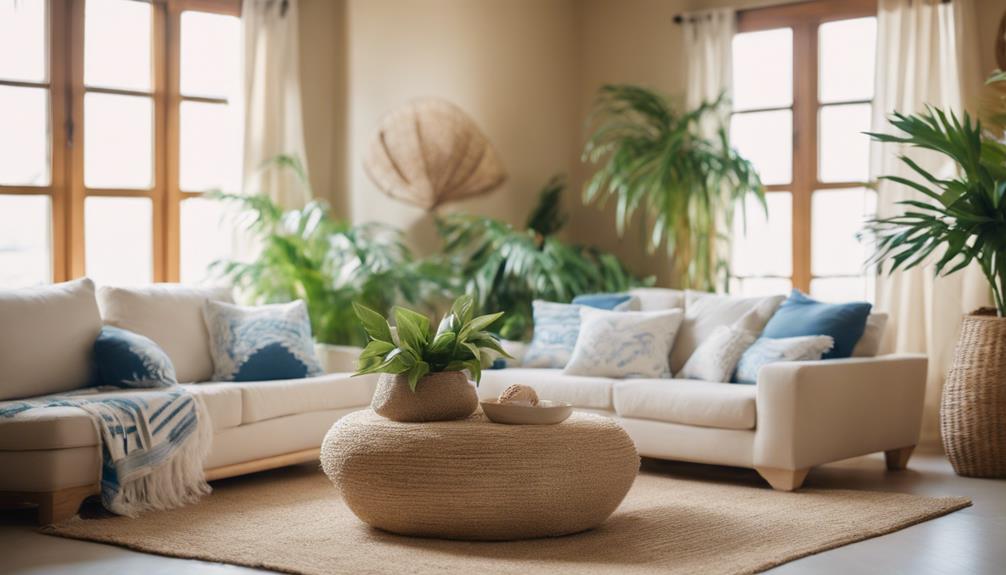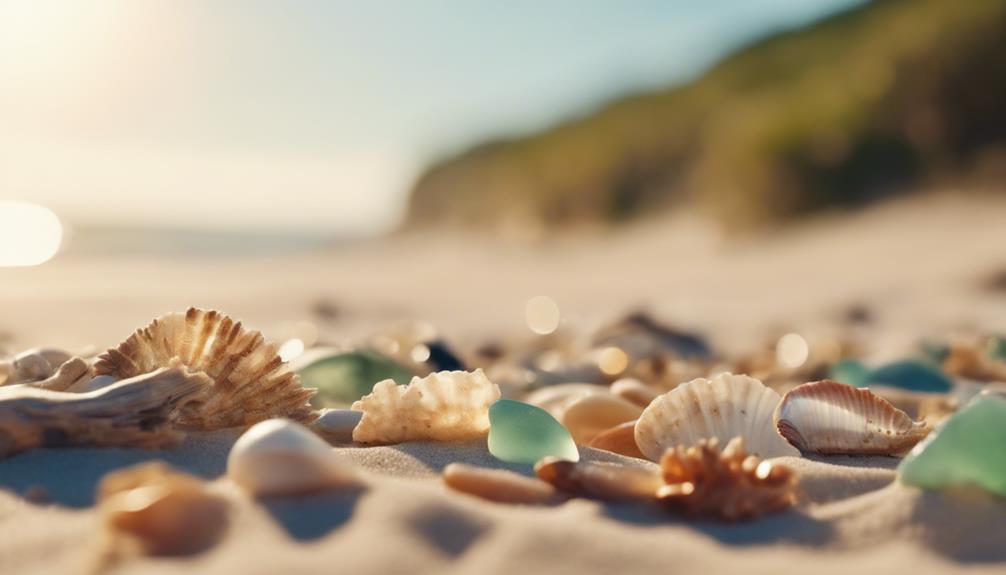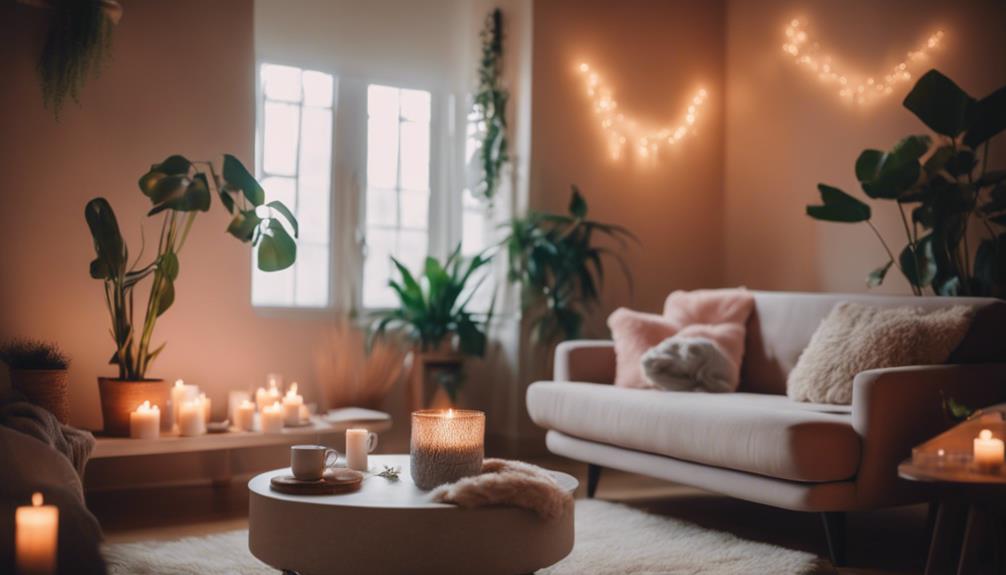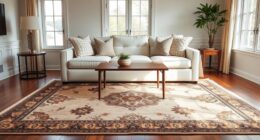Bringing the outdoors inside is all about creating a serene sanctuary in your home. Start with a calming color palette featuring shades of green, brown, and soft blue. Use natural materials like wood, stone, and organic fabrics for added texture and warmth. Incorporate live plants or terrariums to breathe life into your space, and don't forget unique decorative elements like a driftwood wall art piece. Adjustable pendant lights and eco-friendly flooring options, such as bamboo or cork, will complete your nature-inspired look. Stick around for more tips on how to enhance your indoor oasis!
Key Elements
When creating your nature-inspired decor, pay attention to your color scheme, materials, and textures.
Choosing earthy tones and natural materials can bring warmth and a sense of calm to your space.
Color Scheme
A well-chosen color scheme inspired by nature can transform your living space into a sanctuary that promotes relaxation and harmony. Start by incorporating shades like hunter greens, dark browns, and soft blues to create a calming atmosphere reminiscent of the outdoors. These colors not only evoke a sense of tranquility but also connect your interiors to nature.
Consider integrating seasonal color schemes, such as warm autumnal oranges and earthy tones in the fall, to keep your decor dynamic and in tune with the changing environment. This approach helps maintain a cohesive aesthetic throughout your home.
You can also enhance your color scheme by adding decor accents in soothing greens, like Sage and Fern. These hues foster a connection to nature while promoting a sense of well-being.
Lastly, don't forget to use natural fabric patterns featuring floral or leafy designs. They echo the colors and textures found outdoors, further enriching your color scheme.
Materials
Natural materials like wood and stone seamlessly blend indoor and outdoor spaces, elevating your home's aesthetic and atmosphere. By incorporating these natural elements, you create a warm and inviting environment that feels connected to nature. Earthy tones, like hunter greens and dark browns, can transform your space into a calming retreat, encouraging relaxation and tranquility.
To enhance this outdoor-inspired vibe, consider using natural fabrics such as linen, cotton, and jute. These materials in upholstery and textiles contribute to a relaxed ambiance, making your home feel more organic. They also tie in beautifully with your chosen color palette, which can reflect outdoor hues like floral shades and sky blues.
Integrating biophilic design elements, like large windows and open spaces, allows for maximum natural light, fostering a visual connection to the landscape outside. This design approach not only beautifies your space but also boosts your well-being.
Textures
Incorporating various textures into your decor not only enhances visual interest but also creates a tactile experience that draws inspiration from the beauty of nature. By using natural textures like wood, stone, and organic fabrics, you can craft an inviting atmosphere that mimics the outdoors and promotes relaxation. Layering materials, such as jute rugs and wool throws, adds depth and warmth to your space, enhancing the overall sensory experience.
Earthy tones and textures inspired by nature, like terracotta pots and woven baskets, help create a harmonious look that connects your indoor decor to the natural world. When you choose natural textiles, such as linen and cotton, you not only enhance comfort but also contribute to a fresh ambiance that evokes outdoor feelings.
Don't hesitate to engage in DIY projects with natural materials—crafting vases from straw or hemp allows for unique decor that reflects your personal style while fostering creativity. The combination of various textures will transform your space, making it feel more alive and connected to the environment.
Embrace these natural textures, and watch how they elevate your home into a serene retreat.
Essential Fixtures and Furniture

When you're choosing essential fixtures and furniture for your nature room, consider pieces that reflect the beauty of the outdoors.
A live edge wood table or a hammock chair can create a cozy and inviting atmosphere, while a biophilic design accent table can seamlessly integrate greenery into your space.
These selections not only enhance your decor but also foster a deeper connection to nature.
Live Edge Wood Table
A live edge wood table not only highlights the unique beauty of the wood but also serves as a striking centerpiece that connects your space to the outdoors. By showcasing the natural contours of the wood, it preserves the tree's unique characteristics and brings an organic feel to your home. Often crafted from durable hardwoods like walnut, oak, or cherry, these tables add warmth and richness to your decor.
Incorporating a live edge wood table into your space enhances the overall aesthetic by blending rustic charm with modern design. This harmonious balance creates an inviting atmosphere, making it perfect for dining rooms or living areas. The use of natural finishes accentuates the wood's grain and color, ensuring that each piece is one-of-a-kind and visually appealing.
When you choose a live edge wood table, you're not just selecting functional furniture; you're also promoting a connection to nature. It's an embodiment of bringing the outdoors inside, transforming your space into a serene retreat.
Hammock Chair for Relaxation
After adding a live edge wood table to your space, consider enhancing your relaxation experience with a hammock chair that invites you to unwind and enjoy a cozy nook. This unique seating option encourages you to kick back and feel comforted as it gently sways, mimicking the sensation of being outdoors.
Hammock chairs are perfect for creating a tranquil spot in your home, whether you hang one in your living room or sunroom. Made from natural materials like cotton or jute, they add an organic touch to your indoors, enhancing the nature-inspired decor.
Many designs feature vibrant, nature-themed patterns that connect your indoor space with the beauty of the outdoors.
Biophilic Design Accent Table
Biophilic design accent tables seamlessly blend natural materials and organic shapes, creating functional pieces that enhance your indoor oasis. These tables often incorporate reclaimed wood or stone, promoting a connection to the outdoors while elevating your space's aesthetic. By choosing earthy color palettes like greens, browns, and soft neutrals, you can foster a serene atmosphere that invites relaxation.
Consider adding live plants or terrariums atop your biophilic design accent table. Not only do these green elements bring the outdoors in, but they also improve indoor air quality, making your environment more calming. When selecting your accent table, look for designs featuring organic shapes and forms; they mimic natural elements and serve as artistic focal points.
To maximize natural light exposure, opt for tables with glass tops or open frames. This choice enhances brightness, contributing to a light and airy feel in your home. With thoughtful selection, these accent tables can transform your space into a rejuvenating retreat, reminding you of the beauty and tranquility of nature every day.
Lighting Ideas
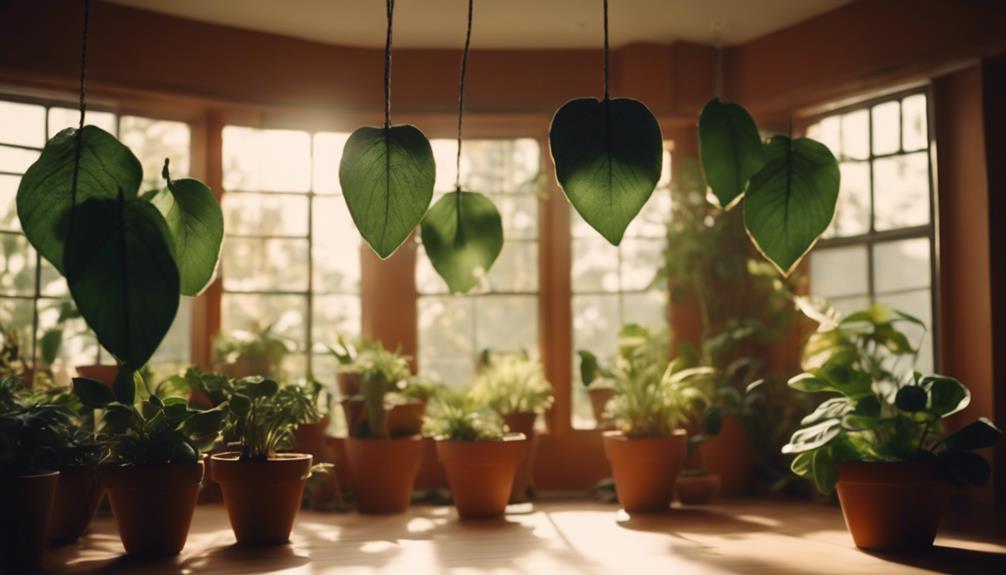
When it comes to lighting your nature-inspired room, you've got some exciting options to explore.
Think about pendant lights with nature motifs or reclaimed wood floor lamps that add warmth and character.
Solar-powered fairy string lights and bioluminescent LED floor lamps can create a magical ambiance, making your space feel like a serene retreat.
Pendant Lights With Nature Motifs
Pendant lights adorned with nature motifs, like leaves and flowers, bring the beauty of the outdoors inside while providing practical lighting solutions. These pendant lights can enhance the organic aesthetic of any room, creating a serene environment that evokes feelings of tranquility and relaxation.
When you choose designs that feature materials like wood and metal, you mirror the textures found in nature, fostering a harmonious connection between indoor and outdoor spaces.
Adjustable pendant lights are a fantastic option, allowing you to customize the lighting levels to suit different moods throughout the day. Whether you want soft, ambient light for a cozy evening or brighter illumination for a lively gathering, these lights can adapt to your needs.
Additionally, opting for eco-friendly pendant lights made from sustainable materials emphasizes your commitment to nature and environmental consciousness.
Incorporating pendant lights with nature-inspired patterns not only enhances your decor but also contributes to an overall calming atmosphere in your home. By integrating these stylish and functional lighting solutions, you can easily transform your space into a sanctuary that reflects your love for nature.
Reclaimed Wood Floor Lamps
Reclaimed wood floor lamps offer a stylish and eco-friendly lighting solution that enhances your space while celebrating sustainability. These lamps not only utilize materials that reduce waste, but they also bring a unique rustic charm to your home decor. The distinct textures and grains of reclaimed wood add character, making each lamp a one-of-a-kind piece that tells a story.
When you incorporate reclaimed wood floor lamps into your decor, you can enjoy adjustable brightness settings, allowing you to create the perfect ambiance for relaxation or social gatherings. Whether you're winding down with a book or hosting friends, these lamps help set the mood.
Moreover, the designs often highlight the wood's natural imperfections, further celebrating the history and craftsmanship behind each piece. By choosing these lamps, you're not just making a design choice; you're also improving your indoor air quality with non-toxic finishes and natural materials.
Incorporating reclaimed wood floor lamps into your home decor is an excellent way to embrace sustainability while adding a warm, inviting glow to your living space.
Solar-Powered Fairy String Lights
Solar-powered fairy string lights transform your space into a magical haven, combining eco-friendliness with enchanting illumination. These lights harness sunlight during the day, allowing you to enjoy beautiful lighting at night without increasing your electricity costs.
With various styles available, from warm white to vibrant colors, you can personalize your decor to create a whimsical or romantic atmosphere in any room.
Installation is a breeze, as solar-powered fairy string lights come with built-in stakes or clips, making it easy to attach them to walls, trees, or any hanging decor—no electrical outlets needed. Plus, many models feature automatic on/off sensors, ensuring they turn on at dusk and off at dawn. This means you can enjoy consistent lighting without having to remember to switch them on.
Durable and weather-resistant, these lights are perfect for both indoor and outdoor spaces, giving you versatile decorating options all year round. Whether you're hosting a garden party or simply want to cozy up your living room, solar-powered fairy string lights add a touch of enchantment that brightens up your life!
Bioluminescent LED Floor Lamps
Bioluminescent LED floor lamps bring a soothing, nature-inspired glow to your space, enhancing the ambiance while reflecting the beauty of the outdoors. These innovative lamps mimic the enchanting light of bioluminescent organisms, creating a calming atmosphere that transforms any room.
With adjustable brightness settings, you can easily customize the intensity of the light to match your mood or activity, making them versatile for any occasion.
One of the standout features of these lamps is their energy efficiency. They consume considerably less power than traditional incandescent bulbs, allowing you to enjoy long-lasting illumination without worrying about your energy bill.
Many designs feature organic shapes and colors, reinforcing your connection to nature and seamlessly integrating into your decor. You can strategically place bioluminescent LED floor lamps to highlight indoor plants or nature-themed decor, further emphasizing the theme of bringing the outside inside.
Whether you're reading a book, enjoying a cozy evening, or hosting friends, these lamps not only illuminate your space but also evoke the tranquility of the natural world. Illuminate your home with these stunning pieces and embrace the serene beauty they offer.
Decorative Elements
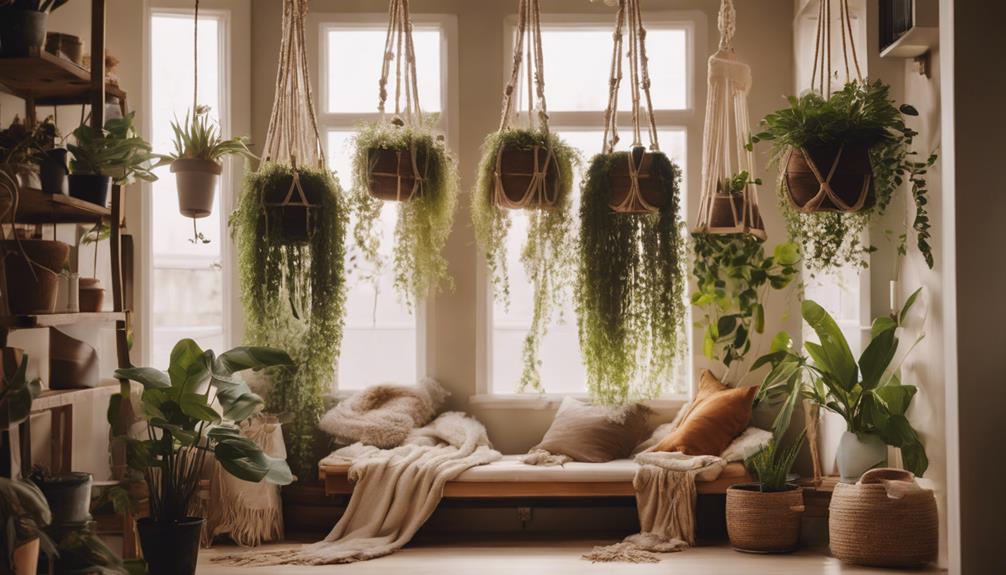
When it comes to decorative elements, you can really enhance your nature room with unique pieces.
Consider adding a terrarium filled with succulents for a touch of greenery, or driftwood wall art that brings an organic feel to your space.
A moss-covered stone centerpiece can also tie everything together, creating a serene and inviting atmosphere.
Terrarium With Succulents
Enhancing your succulent terrarium with decorative elements like colorful stones and miniature figurines can bring your indoor garden to life. When you're creating a terrarium with succulents, consider using vibrant pebbles to create a striking contrast against the green plants. These stones not only add color but also help with drainage, which is vital for your succulents' health.
Miniature figurines can also inject personality into your terrarium. Whether you choose tiny animals, fairy garden pieces, or whimsical structures, these accents can transform your terrarium from a simple plant display into a charming scene. Just be sure they fit the scale of your container to maintain a harmonious look.
Another option is incorporating driftwood or other natural elements for a rustic touch. Remember, your terrarium with succulents needs proper care; keep it in bright, indirect sunlight and allow the soil to dry out between waterings.
Driftwood Wall Art
Creating stunning driftwood wall art not only adds a unique touch to your space but also celebrates the beauty of nature in your home decor. This sustainable decor option utilizes naturally weathered wood, providing an eco-friendly choice that enhances your interiors. You can choose from simple designs featuring a single driftwood branch to more intricate pieces that form shapes like trees or marine scenes.
The organic textures and colors of driftwood bring rustic charm, promoting a calming atmosphere in any room. By incorporating driftwood wall art, you're not just adding visual interest; you're also fostering a deeper connection to nature inside your home. This connection has been shown to enhance well-being and reduce stress.
What's great about driftwood wall art is its versatility. You can easily customize pieces to reflect your personal style, whether you prefer painting them or combining them with other materials like glass or metal. Each piece tells a story, bringing a sense of the outdoors into your living space.
Moss-Covered Stone Centerpiece
A moss-covered stone centerpiece instantly infuses your space with natural beauty, bringing the tranquility of the outdoors inside. This decorative element not only adds a serene touch but also serves as an enthralling conversation starter. Its unique texture and earthy tones enhance your room's overall aesthetic, creating a cozy atmosphere.
One of the best aspects of a moss-covered stone centerpiece is its low-maintenance nature. You won't have to worry about extensive upkeep; just a little care will keep it looking vibrant. The combination of natural stones and lush moss connects you to nature, promoting relaxation and well-being in your environment.
In addition to its visual appeal, this centerpiece can help improve your indoor air quality. By incorporating biophilic design elements like moss, you support a balanced environment that fosters a sense of calm.
Whether you place it on your coffee table, dining table, or bookshelf, a moss-covered stone centerpiece will effortlessly bring the outdoors inside, enriching your living space with its charm. Embrace this beautiful addition and enjoy the peaceful vibes it brings to your home.
Flooring
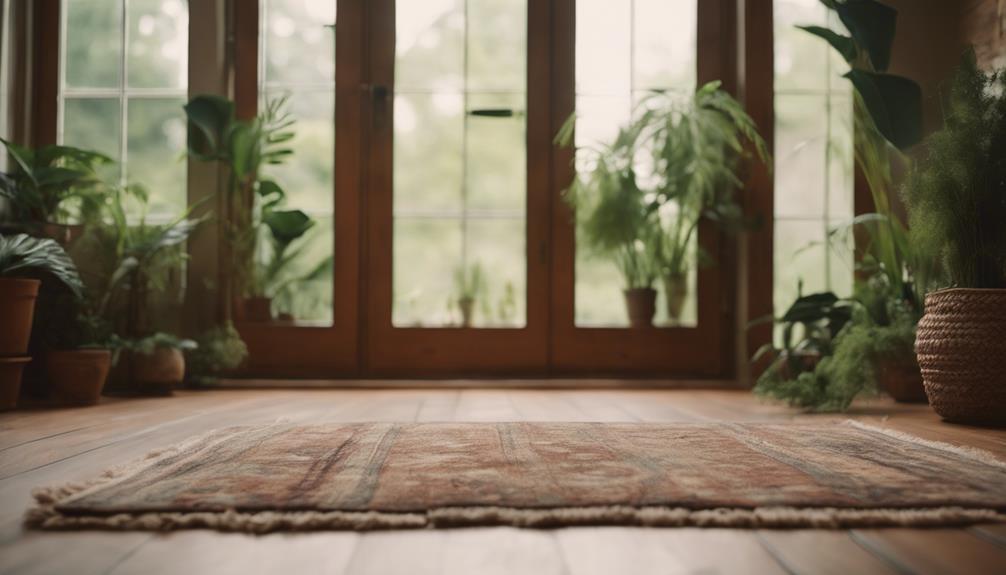
When it comes to flooring, you've got some fantastic options that not only look great but also support sustainability.
Bamboo offers a stylish and eco-friendly choice, while cork provides comfort underfoot.
If you're after rustic charm, reclaimed hardwood brings character and warmth to your space.
Bamboo Flooring for Sustainability
Bamboo flooring offers a sustainable alternative to traditional hardwood, thriving in just 3 to 5 years while enhancing your home's natural beauty. This quick growth means you can enjoy a stylish and eco-friendly flooring option without waiting decades for trees to mature.
Plus, bamboo flooring is incredibly durable and often harder than oak, making it perfect for high-traffic areas in your home.
One of the standout features of bamboo flooring is its natural moisture resistance, which helps prevent mold and mildew. This characteristic makes it suitable for various climates, so you can confidently install it in kitchens, bathrooms, or basements.
Additionally, the manufacturing process for bamboo flooring typically has a lower carbon footprint compared to traditional hardwood options, aligning with your commitment to environmentally-friendly choices.
Available in a range of styles and finishes, bamboo flooring can seamlessly complement your interior design, whether you prefer a modern or rustic look. By choosing bamboo, you not only enhance your space but also promote a connection to nature indoors, making it a wise decision for both your home and the planet.
Consider bamboo flooring for a sustainable and stylish upgrade!
Cork Flooring for Comfort
Cork flooring stands out as another sustainable option, offering both comfort and style while enhancing your home's connection to nature. Made from the bark of cork oak trees, it's an eco-friendly choice that supports environmental conservation. You'll appreciate how cork flooring is naturally resistant to mold, mildew, and pests, promoting a healthier indoor environment for you and your family.
One of the key benefits of cork is its excellent thermal insulation properties, providing a cozy feel underfoot and helping maintain a stable indoor temperature. This feature can even reduce your heating and cooling costs, making it a practical investment.
Plus, the unique cellular structure of cork absorbs sound, creating a quieter, more serene space in your home.
With a variety of styles and finishes available, cork flooring allows you to achieve a sophisticated look while adding a warm, natural aesthetic that complements your decor. By choosing cork flooring, you're not just enhancing your home's comfort; you're also making a stylish statement that brings the beauty of the outdoors inside.
Experience the many advantages of cork flooring and enjoy the perfect blend of sustainability and comfort.
Reclaimed Hardwood for Rustic Charm
Reclaimed hardwood flooring brings a unique rustic charm to your home, effortlessly combining character and sustainability for an inviting atmosphere. By choosing reclaimed hardwood, you're not only enhancing your space but also reducing your environmental impact. This flooring option repurposes old wood, which minimizes the need for new timber extraction.
You'll find various wood species available, each offering distinct colors and grain patterns that add to the rich, textured aesthetic of any room. Plus, the durability of reclaimed hardwood often surpasses that of new wood, as it has already withstood the test of time, making it a reliable choice for flooring.
When you install reclaimed hardwood, you're also improving indoor air quality. This type of flooring is free from harmful chemicals commonly found in new materials, promoting a healthier living environment. With proper care, your reclaimed hardwood can last for decades, serving as both a wise investment in quality and a way to connect with nature through its natural, organic appearance.
Incorporate reclaimed hardwood into your home and enjoy the lasting beauty and charm it brings!
Conclusion
By incorporating nature-inspired decor, you can effortlessly bring the tranquility of the outdoors into your home. Incorporating elements such as earthy color palettes, natural textures, and botanical prints can create a soothing atmosphere that promotes relaxation and a connection to the natural world. Soft and aesthetic room decor, such as cozy linens, fluffy rugs, and organic materials, can further enhance the serene ambiance. By embracing nature-inspired decor, you can transform your living space into a peaceful retreat that rejuvenates the mind and spirit. Consider incorporating leaf prints, wooden accents, and natural textures such as cotton, linen, and jute to evoke a sense of calm and relaxation. Additionally, utilizing a soft pastel color scheme can further enhance the natural ambiance, with colors like sage green, light blues, and pale yellows reminiscent of a peaceful, outdoor setting. Together, these elements can create a harmonious and soothing atmosphere that fosters a deep connection with nature within your living space.
Focus on key elements like essential fixtures and furniture that reflect natural materials, along with lighting that creates a warm ambiance.
Don't forget decorative elements like plants and natural textiles to enhance the vibe.
Finally, choose flooring that complements your theme, tying everything together.
With these tips, you'll create a serene space that invites the beauty of nature inside!
